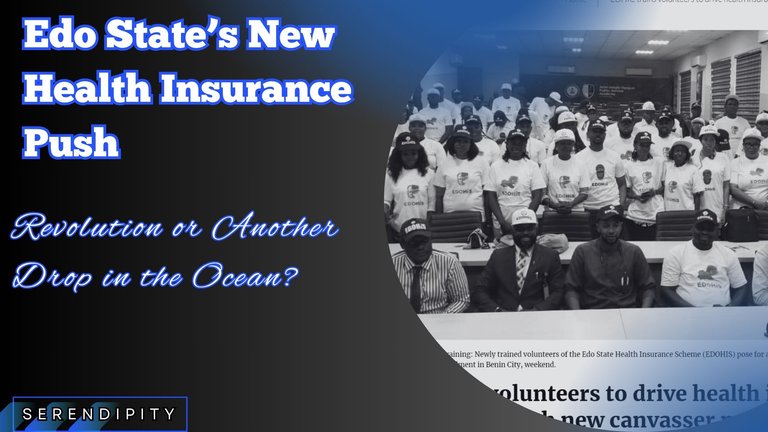
When it comes to healthcare in Nigeria, one thing is certain: we desperately need a system that works. The Edo State Health Insurance Commission (EDOHIC) recently launched a volunteer training initiative at the John Odigie Oyegun Public Service Academy to help push the Edo State Health Insurance Scheme. This “canvasser model” is the first of its kind in Edo and aims to bring healthcare coverage right to the grassroots level. But is this just another big announcement without much backbone?
I’ve worked in Nigeria’s healthcare system, including in Ibadan, where the state’s health insurance scheme, OYSHIA, promised affordable healthcare to the people but left me and my patients underwhelmed. So, while I’m hopeful, I’m a little skeptical about Edo’s new program and what real difference it will make.
Health Insurance in Nigeria: The Big Picture
The Nigerian government has been trying to improve healthcare for years, with little to show for it. The National Health Insurance Scheme (NHIS) was established in 2004 as a landmark initiative for affordable healthcare access. Yet, in practice, the scheme has struggled to meet basic health needs, let alone cover advanced medical treatments. It's like offering a boat with holes—on the surface, it seems like a solution, but it sinks when put to the test.
From what I saw as a doctor in Ibadan, the NHIS barely covered essentials, often only paying for a couple of medications for common issues like malaria. If a patient needed surgery, specialized care, or complex treatment, they were expected to dig into their pockets, insurance or not. I recall many of my patients being disappointed, wondering why they paid for insurance when it couldn’t actually insure them against serious health expenses.
Will Edo’s “Canvasser Model” Change Anything?
Edo State’s new model uses volunteers to spread the word about the health insurance scheme. Trained in sales and equipped with knowledge about the plan’s options, they’ll be heading into communities across the state to encourage sign-ups. While this outreach method is innovative, the real question is: will this program cover the care people actually need, or will it fall into the same trap as NHIS and OYSHIA?
In theory, EDOHIC’s goal to reach all three senatorial districts sounds promising. But if the end product—accessible, comprehensive care—isn’t there, then this effort may just be more smoke without the fire. Volunteers are being encouraged to promote the scheme’s paying plans (which require contributions from enrollees), while “equity plans” cover certain low-income groups. The big hope is that these paying plans create a more sustainable model than free or highly subsidized plans. But let’s be real: insurance that only works on paper doesn’t create the trust needed to get people on board.
A Persistent Problem: Maintenance and Continuity
Another challenge is consistency. Nigerians have a habit of enthusiastically jumping on new programs and ideas, but without the structure to keep these programs well-maintained, things tend to fall apart. We saw this with NHIS. It started strong but faltered as funding, political will, and public interest waned. If Edo’s new scheme is to be successful, it will need sustained management, ongoing training, and transparent funding—a tall order in a system that tends to favor short-term wins.
What We Can Learn from OYSHIA’s Pitfalls
The Oyo State Health Insurance Agency (OYSHIA) tried to provide accessible healthcare through a state-sponsored insurance model, but my experience as a doctor in Ibadan highlighted some serious limitations. OYSHIA, like NHIS, mostly covered basic medications, and sometimes only one or two for common ailments. Patients needing complex treatment, scans, or procedures were left out, with no financial coverage from the insurance they paid into. It felt like the scheme was designed to only be useful when it wasn’t actually needed.
There’s a saying in healthcare that an insurance scheme is only as good as the worst-case scenario it covers. For OYSHIA—and NHIS—this wasn’t the case. If EDOHIS can’t cover the spectrum of patient needs, then how is it different from what we’ve seen before?
Can Edo Get It Right?
To give EDOHIC and EDOHIS credit, they’re taking a new approach by deploying volunteers to canvas at a community level and bringing awareness to the scheme. These volunteers are being trained to build relationships, establish trust, and tailor their approach to different demographics, which is a fresh take. But ultimately, whether Edo State’s health insurance succeeds or fails won’t be determined by these initial launches but by whether the program delivers on its promises.
The underlying problem is whether there’s a true investment in healthcare delivery or just in the appearance of it. We’ve seen well-marketed programs like NHIS and OYSHIA fall short. Edo’s scheme may bring healthcare awareness to the community level, but only time will tell if it also brings genuine access and affordability. For now, I’ll watch with cautious optimism, hoping for a real revolution, but expecting more of the same until proven otherwise.
Thumbnail made with image from The Nigerian Observer
